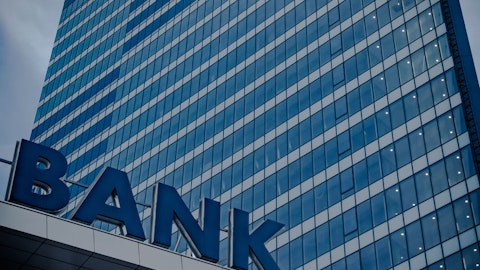James Leonard: Yes. It’s Jamie, Vivek. Yes, it is actually from dividend finance. And the driver of that — there’s some element that’s just normalization as you go through growing a new company, but that’s a smaller part of it. The larger part of it of the increase is actually from our decision to deliver a good customer experience for the borrowers that have had instances where there are delays in getting the solar panel installations to receive permission to operate from the utilities that could also be delayed due to installer performance issues or supply chain shortages. So what we’ve elected to do is different forms of deferment or modification in order to assist the borrowers. And then I would expect this to improve over time as we continue to improve the installer network as well.
Vivek Juneja: So not much loss content you’d expect from that, Jamie then, since it seems like you’re deferring rather than that.
James Leonard: There will be lost content in there. It is appropriately reserved, so not an income impact. But from a solar perspective, we continue to run solar losses around 1% or so. And as we talked about, our deal model was 130 basis points on solar. The challenge we’ve had from a loss content perspective has been on the home improvement side, where dividend had a subprime component to their portfolio that has higher losses. And we stopped originating that product back over a year ago. So there will be some loss content, but I don’t think you would see it impacting income.
Vivek Juneja: Okay. Thank you.
Operator: Your next question comes from the line of Matt O’Connor of Deutsche Bank. Your line is open.
Matt O’Connor: Good morning. I was wondering if you guys can elaborate a bit on the commercial real estate exposure. Obviously, it’s a bit less than peers. And as you noted, no charge-offs last year, but your nonperformers are also into this event and even the office criticized is a relatively low 6% compared to others. So how is it so good? And I guess, are you confident that the marks and estimates are up to date. Thank you.
Greg Schroeck: Yes, it’s Greg. Great question. So yes, very confident in our marks and where we currently are. Also very, very comfortable with the overall asset quality. We’ve been, for the last several years, very disciplined in terms of our client selection. We’re underwriting commercial real estate, specifically office at something below 60% loan to value. We’ve got 90% recourse on that portfolio. And so our borrowers are continuing to exhibit the right behaviors. They’re supporting their projects. They’re writing checks to reduce the debt as necessary. We’re out ahead of that portfolio. The maturities are evenly split over the next four to five years. We don’t have that so-called wall of maturities that we’ve heard from some other banks and you’ve heard in the marketplace. So I do feel very good about the overall portfolio, our office included.
Matt O’Connor: And then just more broadly speaking, obviously, the overall charge-off outlook for this year is fairly benign 35 to 45 basis points. Any more color in terms of drivers of call it, the midpoint of that range versus 2023 levels?
Greg Schroeck: I think we’re going to continue to see a lot of what we saw in 2024 with what we saw in 2023, right? We don’t have any significant trends geographically or by product. And so what we saw in 2023 was a little bit more episodic. And based on what we’re seeing on the C&I side right now, I mean, our borrowers have done a nice job both on the executing on the revenue expense management side, there’s obviously margin compression. But overall, as Tim said earlier, they’re looking for the same things we’re looking for, which is what is the Fed going to do and when. We hear a lot about labor costs, so they’re keeping their eye on that. So I think we’re going to have a lot of the same old same old, certainly as we get into the first and second quarters in terms of what we’re seeing both from a loss content and commercial real estate minimal and C&I, right?
We will have a name pop up every once in a while we’ll deal with it. But again, we’re not seeing trends that would lead me to believe that our criticized assets — our overall asset quality is going to move much from where it is right now. Again, as we sit here today heading into the first quarter.
Matt O’Connor: Okay. That’s helpful. Thank you.
Operator: Your next question comes from the line of Christopher Marinac of Janney Montgomery Scott. Your line is open.
Christopher Marinac: Hey, thanks. Good morning. Can you remind us how the commercial C&I DDAs behave on a down rate environment? And is there any reason to believe that they wouldn’t kind of behave positively in your favor this time?





